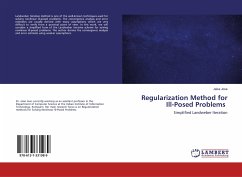
Well-posed Problem
Versandkostenfrei!
Versandfertig in 6-10 Tagen
23,99 €
inkl. MwSt.

PAYBACK Punkte
12 °P sammeln!
High Quality Content by WIKIPEDIA articles! The mathematical term well-posed problem stems from a definition given by Jacques Hadamard. He believed that mathematical models of physical phenomena should have the properties that: 1. A solution exists 2. The solution is unique 3. The solution depends continuously on the data, in some reasonable topology. Examples of archetypal well-posed problems include the Dirichlet problem for Laplace's equation, and the heat equation with specified initial conditions. These might be regarded as 'natural' problems in that there are physical processes that solv...
High Quality Content by WIKIPEDIA articles! The mathematical term well-posed problem stems from a definition given by Jacques Hadamard. He believed that mathematical models of physical phenomena should have the properties that: 1. A solution exists 2. The solution is unique 3. The solution depends continuously on the data, in some reasonable topology. Examples of archetypal well-posed problems include the Dirichlet problem for Laplace's equation, and the heat equation with specified initial conditions. These might be regarded as 'natural' problems in that there are physical processes that solve these problems. By contrast the inverse heat equation, deducing a previous distribution of temperature from final data is not well-posed in that the solution is highly sensitive to changes in the final data. Problems that are not well-posed in the sense of Hadamard are termed ill-posed. Inverse problems are often ill-posed.












